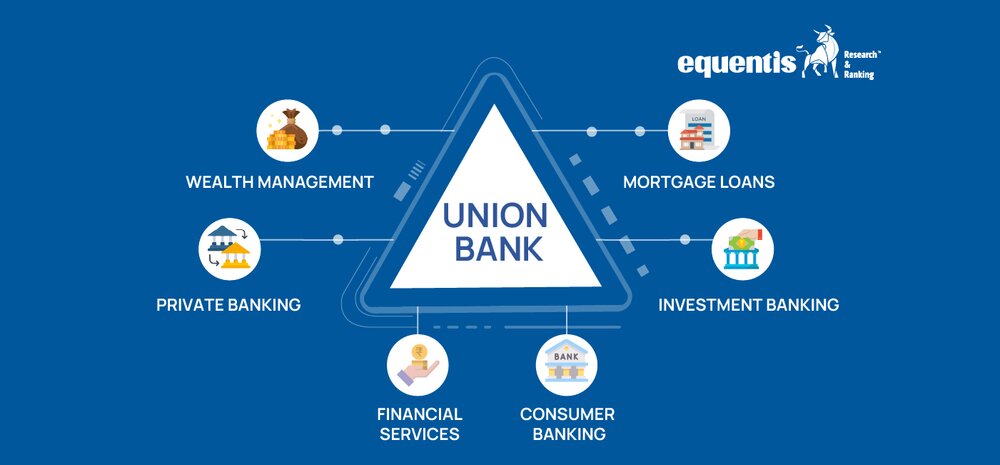Union Bank is the fifth largest public sector bank of India with a customer base of over 21 crore Indians. In the consolidation drive, Andhra Bank and Corporation Bank were merged into Union Bank in April 2020.
The bank’s business and income have more than tripled since then, helping Union Bank share price to rise more than 140% in the last five years, from ₹44.20 on 20 Feb 2020 to ₹107.6 on 17th Feb 2025. It made a high of ₹172.
Union Bank has one of the best asset quality among Indian public sector banks and has a strong growth potential in the long run. In this article, we do a fundamental analysis of Union Bank share price to have a better understanding of the bank’s standing.
Overview of Union Bank of India
Union Bank of India is a leading public sector bank with its headquarter in Mumbai. The bank was established in 1919 and over years have diversified its offering to meet varied needs of its customers, ranging from individuals to large corporations.
It offers personal banking, corporate banking, international banking, and treasury operations services through its 8,500+ domestic branches, 9,000+ ATMs, and 23,000+ business correspondents.
As of 31st December 2024, the bank’s total business stood at ₹21.65 lakh crore, comprising ₹12.16 lakh crore in deposits and ₹9.5 lakh crore of advances.
Union Bank of India Management Profile
Ms. A. Manimekhalai is the CEO and Managing Director of Union Bank. She is a seasoned banker with over three decades of experience and started her career as an officer in Vijaya Bank in 1988. Prior joining Union Bank, Ms. Manimekhalai was Executive Director at Canara Bank overseeing strategic planning, credit related matters, financial inclusion, functioning regional rural banks, and others. She holds an MBA (Marketing) from Bangalore University, and a Diploma in Human Resource Management from Narsee Monjee Institute of Management Studies (NMIMS), Mumbai.
Shri P. K. Samal is the Chief Compliance Officer and has been appointed for a tenure for 3 years from June 2024. He is a certified chartered accountant and has over 21 years of experience in banking space.
Shri Avinash Vasant Prabhu is the Chief Financial Officer of Union Bank and was appointed in November 2023 for a period of 3 years. He is a chartered accountant by profession and has more than 25 years of experience. Prior to joining Union Bank, he was CFO India for Deutsche Bank.
Shri Ashwini Kumar Choudhary is the group Chief Risk Officer with over 24 years of professional experience. He is a certified FRM from Global Associations of Risk Professionals.
Union Bank of India Shareholding Pattern
Financial Performance
Net Interest Income (NII)
The bank’s net interest income reached ₹36,570 crores during FY24, which is around 11.6% higher compared to the previous financial year from ₹32,765 crores.
In the April to December period (9MFY25), the bank’s NII reached ₹27,700 crores, which is around 2% higher at ₹27,134 crore recorded during the period in 9MFY24. The bank non-interest income rose 25.33% during the same period to ₹14,254 crores.
Net Profit
From recording a loss of around ₹2,900 crores in FY20, the bank’s profitability metric has improved a lot. In FY24, net profit of the company reached ₹13,648 crores, from ₹8,433 crores in FY23, recording a growth of 62%.
For the 9MFY25, the bank’s net profit increased by 25.77% to ₹13,002 crores from ₹10,338 crores recorded in 9MFY24.
Key Financial Metrics
Net Interest Margin (NIM)
Net Interest Margin is like operating margin for banks and is calculated by interest paid from interest earned. In FY24, the NIM of Union Bank of India was 3.1%, improved by 3 basis points year-on-year.
And for the 9MFY25 period, it was 2.94% and the bank has given guidance of 2.8 to 3% as NIM for FY25, on account of lower lending margin and high deposit cost.
Gross Non Performing Asset (NPA)
| Period | GNPA (%) |
| FY20 | 14.15 |
| FY21 | 13.74 |
| FY22 | 11.11 |
| FY23 | 7.53 |
| FY24 | 4.76 |
| 9MFY25 | 3.85 |
The bank has steadily improved its asset quality over the years. In FY24, the Gross Non Performing Asset (GNPA) of the bank improved to 4.76% from 7.53% in FY23. It further improved to 3.85% for the period ending in December 2024, indicating better asset and risk management to prevent slippages and loans from turning bad.
Management is expecting the bank’s GNPA for FY25 to settle below 4%.
Capital Adequacy Ratio (CAR)
Capital Adequacy Ratio- which indicates the bank’s financial strength and stability The overall CAR at the end of December is 16.72% against the minimum regulatory requirement of 12% for public sector banks.
A higher CAR indicates that the bank is well insulated to absorb any shock like a spike in non performing assets.
CASA Ratio
The Current Account Saving Account (CASA) Ratio, which indicates percentage of customer’s total deposit kept in low yielding current and savings accounts, is 33.43% at the end of December 2024. SBI, which is the leader, has a CASA of 39.20%.
Cost of Deposits and Cost of Funds
The bank’s Cost of Funds for the 9MFY25 increased by 28 bps to 4.98%. And, the cost of deposit also increased to 5.5% for the same period from 5.15% recorded the previous year. Higher cost of funds and deposit, put a pressure on the profitability metrics of the bank.
Union Bank Share Price Analysis
After reaching a high of ₹172 on 3rd June 2024, Union Bank Share Price is on a downtrend, and has corrected by more than 30%. This correction may be due to the broader weakness in the market and macro slowdown.
Speaking about the dividend payouts, Union Bank has a consistent dividend payout history has one of the highest dividend yields across public sector banks.
The bank paid ₹1.9 in 2022, ₹3 in 2023, and 3.60 in 2024 as dividend. At the current market price of ₹114, the bank has a dividend yield of 3.13%.
Know More: SEBI Registered investment advisory | Stock investment advisory
Key Valuation Metrics
Earning Per Share (EPS)
The following is the EPS of Union Bank Share Price of last 5 year:
| FY20 | – ₹12.49 |
| FY21 | ₹4.54 |
| FY22 | ₹7.73 |
| FY23 | ₹12.34 |
| FY24 | ₹18.95 |
| 9MFY25 | ₹17.05 |
The bank has considerably improved its Earning Per Share over the last five years from negative ₹12.49 per share to ₹18.95 per share, which aided in the share price rise.
Return on Assets
The bank’s Return on Assets (ROA) in FY24 improved from 0.69% in FY23 to 1.03% and for the 9MFY25, the bank’s ROA further improved to 1.24%.
Price-to-Book VS Median Price-to-Book
The price-to-book value of Union Bank share price is 0.9 and the 5 year Median Price-to-Book is 0.5, meaning it is trading slightly higher than its book value, and also below book value. It can be considered fairly valued for this metric.
Union Bank Share Price Future Growth Potential
Although the financials of the bank look steady with improving profits, NPA ratio, net interest margin, the bank may face operational risks.
Union Bank’s credit growth for the 9MFY25, grew by 5.94%, lower by the management’s expectation of 11%. And, the deposits growth was 3.76%. Lower deposit growth may impact the bank’s ability to aggressively pursue credit growth and may have to raise funds from the market to fund the growth, which can impact the cost of funds for the bank.
Another key concern for the bank will be a period of flat growth. For 9MFY25, the bank’s Net Interest Income growth was flat, which again can impact the growth of Union Bank share price.
The bank’s CASA ratio is also on a declining trend, which again can increase the cost of funds and impact profitability.
Going forward, the bank’s credit and deposit growth should be closely analyzed to understand the future growth potential of Union Bank share price and also compare the metrics with State Bank of India.
Related Posts
Disclaimer Note: The securities quoted, if any, are for illustration only and are not recommendatory. This article is for education purposes only and shall not be considered as a recommendation or investment advice by Equentis – Research & Ranking. We will not be liable for any losses that may occur. Investments in the securities market are subject to market risks. Read all the related documents carefully before investing. Registration granted by SEBI, membership of BASL & certification from NISM in no way guarantee the performance of the intermediary or provide any assurance of returns to investors.
FAQ
Is Union Bank of India a government bank?
Yes, Union Bank of India is India’s 5th largest public sector bank with pan India presence.
How has Union Bank Share price performed in the last 5 years?
As of 10th Feb 2025, Union Bank share price has given an annualized return of 21% in the last 5 years.
What is CASA in Union Bank?
The CASA Ratio of Union Bank at the end of December 2024 is 33.43%, down by 97 bps from 34.40 in December 2023.
How useful was this post?
Click on a star to rate it!
Average rating 0 / 5. Vote count: 0
No votes so far! Be the first to rate this post.
I’m Archana R. Chettiar, an experienced content creator with
an affinity for writing on personal finance and other financial content. I
love to write on equity investing, retirement, managing money, and more.
- Archana Chettiar




























































